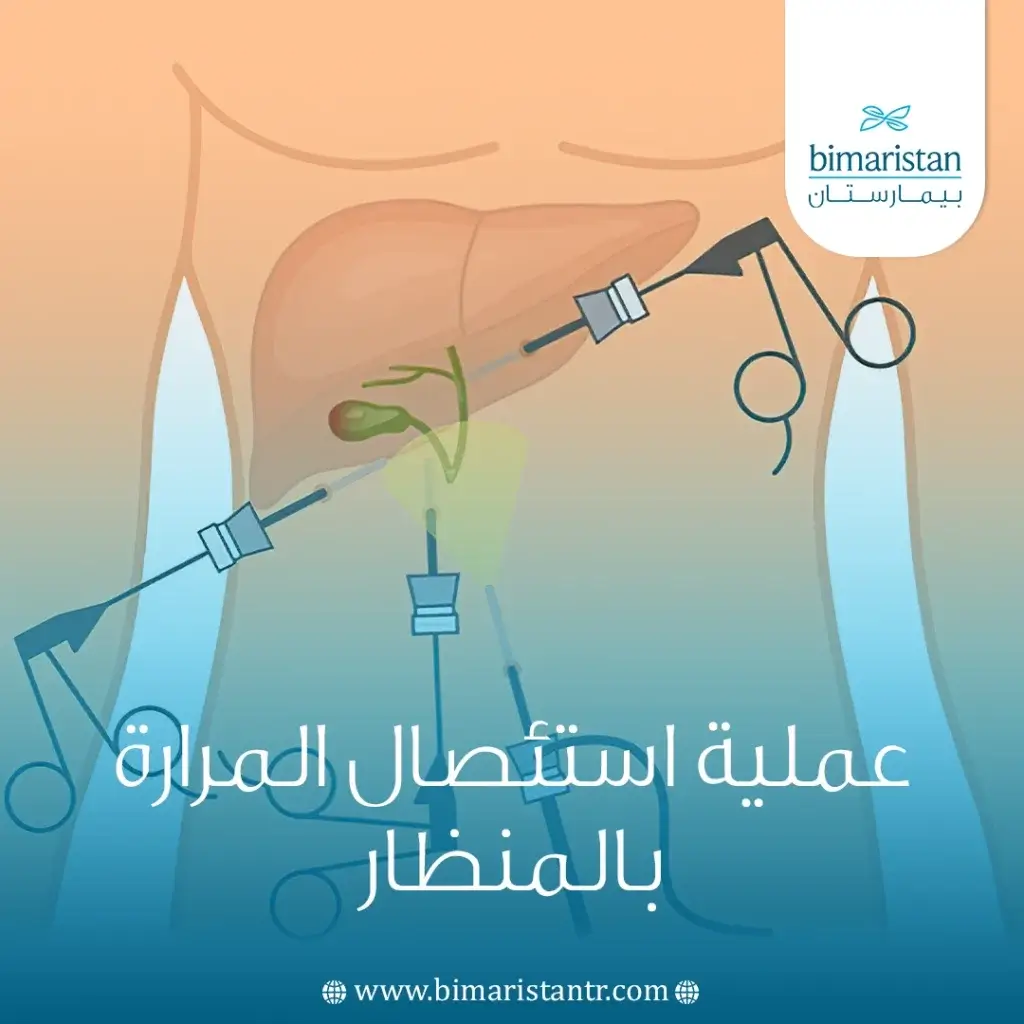إن تشكل حصى مؤلمة في المرارة يعد مشكلة شائعة وخطيرة إذا لم تعالج، يمكنك الآن إجراء عملية استئصال المرارة بالمنظار في تركيا ومنع هذه الحصوات من التشكل مجدداً والعودة إلى منزلك في نفس اليوم.
لمحة عن المرارة
المرارة عبارة عن عضو صغير كمثري الشكل يقع تحت الكبد في الربع العلوي الأيمن من البطن تؤدي وظيفة جمع وتخزين الصفراء (سائل ينتجه الكبد تساعد على هضم الدسم) وزيادة تركيزها.
عندما يصل الطعام الحاوي على الدسم إلى المعي الدقيق تتقلص المرارة وتقوم بإفراز الصفراء إلى المعي الدقيق عبر الأقنية الصفراوية.
إن تغير تركيب وتركيز الصفراء المخزنة في المراره بسبب الهرمونات أو الأدوية أو التغيرات السريعة في الوزن أو الحمية الغذائية قد يؤدي إلى تشكل كتل صلبة من الصفراء تسمى الحصوات الصفراوية.

تحصي المرارة
يعد تحصي الصفراء مرضاً شائعاً جداً وقد يترافق مع ألم بطني متقطع وغثيان وإقياء، عادةً بعد تناول الطعام.
يزداد احتمال تشكل الحصوات الصفراوية عند النساء وخصوصاً اللواتي أنجبن أطفالاً والبدينين والأشخاص الذين تجاوز عمرهم 40 سنة وعند وجود سوابق عائلية لتحصي المراره.
يمكن للحصوات الصفراوية المتشكلة في المرارة أن تخرج منها إلى الطرق الصفراوية وتقوم بسد التدفق الطبيعي للصفراء مما يؤدي إلى ركودة صفراوية تتظاهر بألم بطني حاد وغثيان وإقياء وعسر هضم وحمى ويرقان (لون أصفر للجلد) من النوع الانسدادي، هذه الركودة تؤهب لحدوث التهاب المرارة وإصابتها بالإنتانات.
يتظاهر التهاب المرارة بألم بطني حاد مستمر وحمى وغثيان وإقياء مما يستدعي زيارة الطبيب الذي يقوم بإجراء إيكو بطن لتأكيد التشخيص وإحالة المريض إلى الجراحة عند الحاجة.
إذا توقفت تلك الحصوات المرارية في مستوى القناة الجامعة وقامت بسدها يتوقف تدفق العصارة البنكرياسية أيضاً وتتفعل الأنزيمات البنكرياسية الهاضمة داخل البنكرياس والذي ينتج عنه حدوث التهاب البنكرياس، بالإضافة إلى أعراض الركودة الصفراوية المذكورة سابقاً.

أسباب استئصال المرارة
قد لا تحتاج الحصيات المرارية إلى علاج إذا كانت صغيرة ولم تتسبب بمشاكل.
يستطب إستئصال المرارة في إحدى الحالات التالية:
- تحصي المرارة (تشكل حصوات عديدة مختلفة الأشكال والأحجام داخل المرارة)
- وجود الحصوات الصفراوية داخل الأقنية الصفراوية
- التهاب المرارة
- تشكل سليلات (بوليبات) مرارية
- التهاب البنكرياس بسبب الحصوات الصفراوية
- سرطان المرارة
يستطب في حالات قليلة تناول حبوب لحل الحصوات الصفراوية ولكنها لم تثبت فعاليتها في علاج تحصي المرارة مما يجعل عملية استئصال المرارة هي العلاج الأمثل في معظم الحالات.
عمليّة استئصال المرارة
يوجد في تركيا طريقتين لإجراء جراحة استئصال المرارة cholecystectomy:
عملية المرارة بالجراحة المفتوحة (التقليدية) open cholecystectomy: وفيها يقوم الجراح بفتح البطن واستئصال المرارة عبر شق جراحي بطول 12.5-17.5 سم على الجانب الأيمن تحت الأضلاع بحيث يمكن للجراح رؤية المرارة وفصلها عن الأعضاء المجاورة، ثم يقوم الجراح بقطع قناة الصفراء والأوعية التي تغذي المرارة ثم يستأصلها، تستغرق مثل هذه العمليات ساعة أو ساعتين.

عملية المرارة بالمنظار (التنظيرية) laparoscopic cholecystectomy: وفيها يقوم الجراح بإجراء أربع شقوق صغيرة طول كل واحد منها اقل من 2.5 سم (أقل من واحد إنش) لإدخال أنبوب طويل رفيع مجهز بآلة تصوير دقيقة وأدوات جراحية يدعى منظار البطن، قد يتم ضخ أكسيد الكربون عبر هذه الشقوق داخل جوف البطن لنفخ المنطقة الجراحية وتسهيل الرؤية، حيث يقوم الجراح بإجراء هذه العملية وهو ينظر إلى شاشة المراقبة، ثم تتم إزالة المرارة عبر أحد هذه الشقوق، تستغرق هذه العملية ساعة أو ساعتين أيضاً.

يتم إجراء العمليتين السابقتين تحت التخدير العام أي أن المريض يكون نائماً خلال العملية ولا يحس بأي ألم أثناء تنفيذها.
أضرار استئصال المرارة
تحمل عملية استئصال المرارة خطورة حدوث بعض المضاعفات منها:
- النزف
- الانتان وحدوث التهاب البريتوان
- إصابة القناة الصفراوية التي تحمل الصفراء من المرارة إلى المعي الدقيق
- أذية الكبد
- الندب الجراحية والإحساس بالخدر مكان الشق الجراحي
- حدوث فتق في مكان الجراحة
- ثقب المعي الدقيق في عمليات استئصال المرارة بالمنظار
- الآثار الجانبية للتخدير العام مثل تشكل الخثرات وحدوث ذات الرئة
- التهاب المجاري البولية
معظم هذه المضاعفات هي مضاعفات نادرة الحدوث، أي أنها تقريباً لا تحدث مطلقاً.
فوائد استئصال المرارة
إن استئصال المرارة سيزيل الألم ويعالج الالتهاب الناجم عن الحصوات الصفراوية ويمنع تشكلها مجدداً.
في حال عدم معالجة تحصي المرارة سيزداد الألم والانتان سوءاً وقد تنفجر المرارة وتهدد حياة المريض.
محاسن عملية استئصال المرارة بالمنظار
تمتلك عملية استئصال المرارة بالمنظار الكثير من الميزات تجعلها أفضل من عملية استئصال المرارة بالجراحة المفتوحة منها:
- أقل ألماً
- أقل خطراً لحدوث المضاعفات
- الشفاء والعودة للنشاطات اليومية بشكل أسرع
- شقوق جراحية أصغر وبالتالي ندب جراحية أصغر
وقد أظهرت العديد من الدراسات فعاليتها عند اختيار المرضى المناسبين لإجراء هذه العملية.
إذ إن عملية استئصال المرارة بالمنظار غير مناسبة لجميع الأشخاص، وقد نضطر بعد البدء بالجراحة التنظيرية إلى تحويل المريض إلى الجراحة المفتوحة.
بعض الحالات التي تستدعي إجراء جراحة مفتوحة أو التحويل إليها:
- مرارة المريض متأذية بشدة بسبب التندبات أو الالتهابات
- بطن المريض يحتوي على ندب جراحية ناتجة عن جراحات سابقة
- السمنة الشديدة
- لا يستطيع الجراح الرؤية داخل بطن المريض بشكل جيد باستخدام المنظار
- إذا تعرض المريض لمشاكل نزفية أثناء الجراحة
لا يعتبر التحول إلى الجراحة المفتوحة مشكلة بالنسبة للمريض، سيقرر الطبيب الجراح الخيار العلاجي الأمثل والأكثر سلامة لاستئصال المرارة.
الحياة بعد استئصال المرارة
يمكن للإنسان أن يعيش حياة طبيعية بعد استئصال المرارة حيث يتكيف الكبد مع الحالة ويقوم بإنتاج كمية كافية من الصفراء لهضم الطعام، لكن بدلاً من تخزينها في المرارة ستفرز مباشرة في الجهاز الهضمي.
إن المرضى الخاضعين لعملية استئصال المرارة بالمنظار غالباً ما يعودون إلى المنزل في نفس اليوم الذي أجريت فيه العملية أو يبيتون ليلة واحدة في المستشفى، ويستغرق الشفاء التام حوالي أسبوع.
أما المرضى الخاضعين لعملية استئصال المرارة بالجراحة المفتوحة فيحتاجون إلى قضاء يومين إلى ثلاثة أيام في المستشفى، ويستغرق الشفاء التام 4-6 أسابيع.
يمكن للمرضى العودة إلى تناول الطعام بشكل طبيعي فور عودتهم إلى المنزل.
من الشائع أن يشعر المريض بألم خفيف إلى متوسط في مكان إجراء العملية خلال عدة أيام بعد الجراحة يتم تدبيره بمسكنات الألم، قد يشعر المريض أيضاً بألم في أكتافه يزول تلقائياً بعد يوم أو يومين من العملية.
يمكن إزالة الضمادات في اليوم التالي للجراحة، مما يسمح للمريض بالعودة إلى الاستحمام بشكل طبيعي (قد تحتاج بعض الجروح إلى عناية خاصة).
قد يعاني بعض الأشخاص من إسهال بعد عملية استئصال المرارة يزول تلقائياً بعد بضعة أسابيع أو أشهر في أغلب الأحيان.
نصائح بعد استئصال المرارة
بعد إجراء عملية استئصال المرارة هناك بعض النصائح تساعد المريض على التعافي بشكل أسرع منها:
- تجنب حمل الأغراض الثقيلة
- الحرص على شرب كمية كافية من المياه يومياً
- تناول الطعام الغني بالألياف للمساعدة على حركة الأمعاء
- اتباع نصائح الطبيب في العناية بالجرح وتناول الأدوية
- زيادة النشاطات اليومية تدريجياً
- يساعد المشي لمسافات قصيرة يومياً على تجنب حدوث الخثرات
يجب على المريض أن يتواصل طبيبه إذا واجه أياً من المشكلات التالية بعد عملية استئصال المرارة:
- حمى تتجاوز 38.5 درجة مئوية (101 فهرنهايت)
- ألم شديد لا يستجيب على المسكنات أو تورم مكان الجراحة
- يرقان (لون أصفر للجلد)
- عدم القدرة على تناول الطعام والشراب بسبب الغثيان والإقياء
- نزيف أو نز من مكان العملية
- مشاكل تنفسية أو سعال لا يتحسن تلقائياً
مركز بيمارستان الطبي هو خيارك الأول للعلاج في تركيا.
نرشدك لأفضل الأخصائيين الخبراء بكافة الأقسام.
نسهّل لغة التواصل بينك وبين الجميع عن طريق أطباء عرب متخصصين سيساعدونك في التواصل مع طبيبك.
نساعدك في تأمين العلاج المناسب والخدمة الراقية في أحدث المشافي والمراكز الطبية في تركيا.
نقدم خدماتنا على امتداد كبير وبشكل دقيق.
نرافقك خطوة بخطوة نحو الشفاء.
استشارات مجانية على مدار الساعة.
لا تتردد بالتواصل معنا، مركز بيمارستان عائلتك في تركيا.

